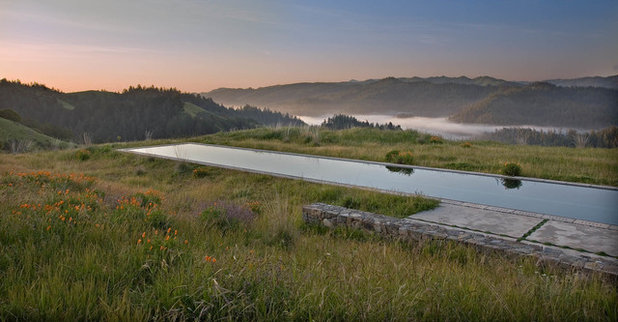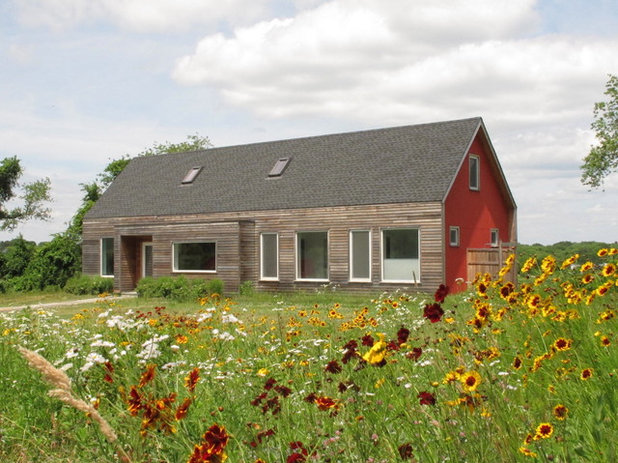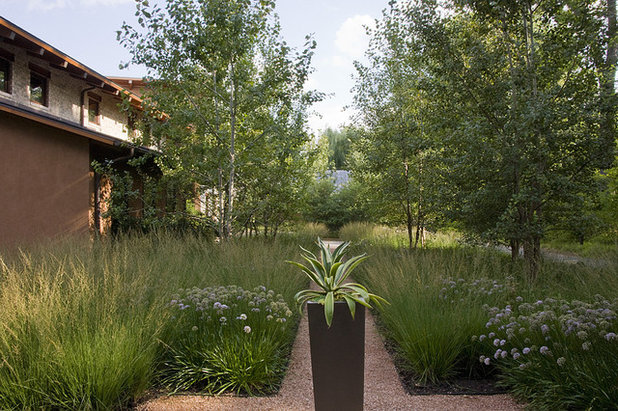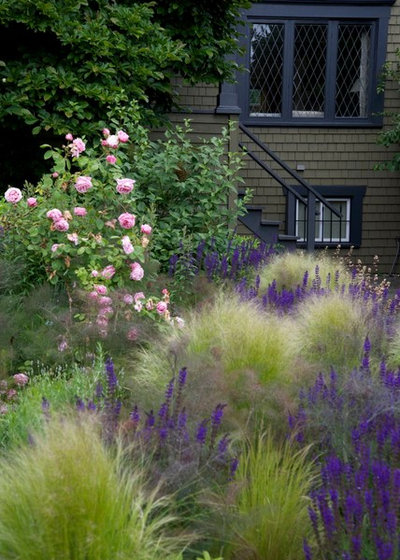You’d like to evoke the spirit of a meadow in your garden bed or expanse of former lawn, but you don’t want it to appear weedy or messy, or grow higher than a jumbo jet. You know that to win over neighbors, it will have to look good and do even more than the typical landscape — bring in butterflies to ooh and aah over, for example. Plus, just for fun, it has to be as little work as possible. That’s a tall order, but we’ll take a stab at it.

bernard trainor + associates
The Ingredients
Base layer. The key to any meadow is the base layer, or matrix. This is usually composed of some combination of warm-season grasses (which grow and flower in the hot summer) or cool-season sedges (which grow and flower in spring and regrow in fall). You can mix grasses and sedges (
Carex spp.), but it may start to look like a hodgepodge, especially in a small area.
Pick one type of base layer and run with it. I prefer sedges because they will green up long before your neighbors’ lawns do and hold their own all summer, cooling the soil and helping to keep down weeds. You probably also want to stick to one species of sedge. Some stalwart and adaptable species include Bicknell’s sedge (
C. bicknellii), which prefers dry sun; Sprengel’s sedge (
C. sprengellii), which likes dry to medium shade; and shortbeak sedge (
C. brevior), which handles sun or shade and dry or moist conditions.
Plant your bed, spacing the centers of the plants a foot apart. Any farther, and you risk weeds more easily establishing in the gaps — though weeds will certainly need attention in the first year or two, especially.
Meet a Lawn Alternative That Works Wonders

Nilsen Landscape Design, LLC
Flowers. We can plant ornamental flowers in drifts or clumps in the gaps in the base layer. These flowers can be a bit shorter than the grasses or sedges to create an additional ground cover — think purple poppy mallow (
Callirhoe involucrata), pasque flower (
Pulsatilla patens) or prairie smoke (
Geum triflorum) — or they can be the same height to provide a more uniform and manicured look.
Plants to interweave among the base layer could include nodding onion (
Allium cernuum), aromatic aster (
Symphyotrichum oblongifolium), butterfly milkweed (
Asclepias tuberosa), Virginia mountain mint (
Pycnanthemum virginianum), white wood aster (
Eurybia divaricata) or dotted blazing star (
Liatris punctata).
An unexpected height or a contrasting architectural form here and there are also welcome. This would include plants along the lines of dwarf blue indigo (
Baptisia australis var.
minor), pale purple coneflower (
Echinacea pallida), Joe Pye weed (
Eutrochium purpureum), rattlesnake master (
Eryngium yuccifolium), calico aster (
Symphyotrichum lateriflorum) or smooth aster (
S. laeve). Slender plants like meadow blazing star (
Liatris ligulistylis) or tall blazing star (
L. aspera) can also weave in there.
Remember, your plant selections should be tailored accurately to your light, soil and drainage conditions — and your region.

AHBL
Putting It All TogetherAll in all, maybe you have 65 percent grasses or sedges and 35 percent flowers — feel free to play around with that ratio. For the flowers, plant about 10 percent flowering ground cover plants that nestle in and weave among the base layer. Then, 20 percent can be clumps or drifts of similar or slightly taller flowers that provide constant blooming and maybe 5 percent architectural plants.
Keep in mind that sedges have fibrous root zones, so you’ll want to plant flowers that have deep taproots — to more easily access nutrients beneath the sedge roots — or are similarly competitive, so neither one beats the other into submission. For example, you don’t want to put an aggressive mint among the sedges because it will soon choke out those sedges and win the battle.

The Garden Consultants, Inc.

CYAN Horticulture
Bed size, site conditions and your aesthetic preference will play a part in what and how you plant. For a more formal or calming look, you may want only one species blooming at a time. For a wilder look, you can begin letting go of the reins a bit, letting more bloom at once, and varying the heights and textures.
Experiment and play. Always remember that a natural meadow is constantly changing — not just from season to season but from year to year. Embrace and be excited by the loss of some plants and the spread of others. I can’t think of a better teacher in life than a community of plants.





